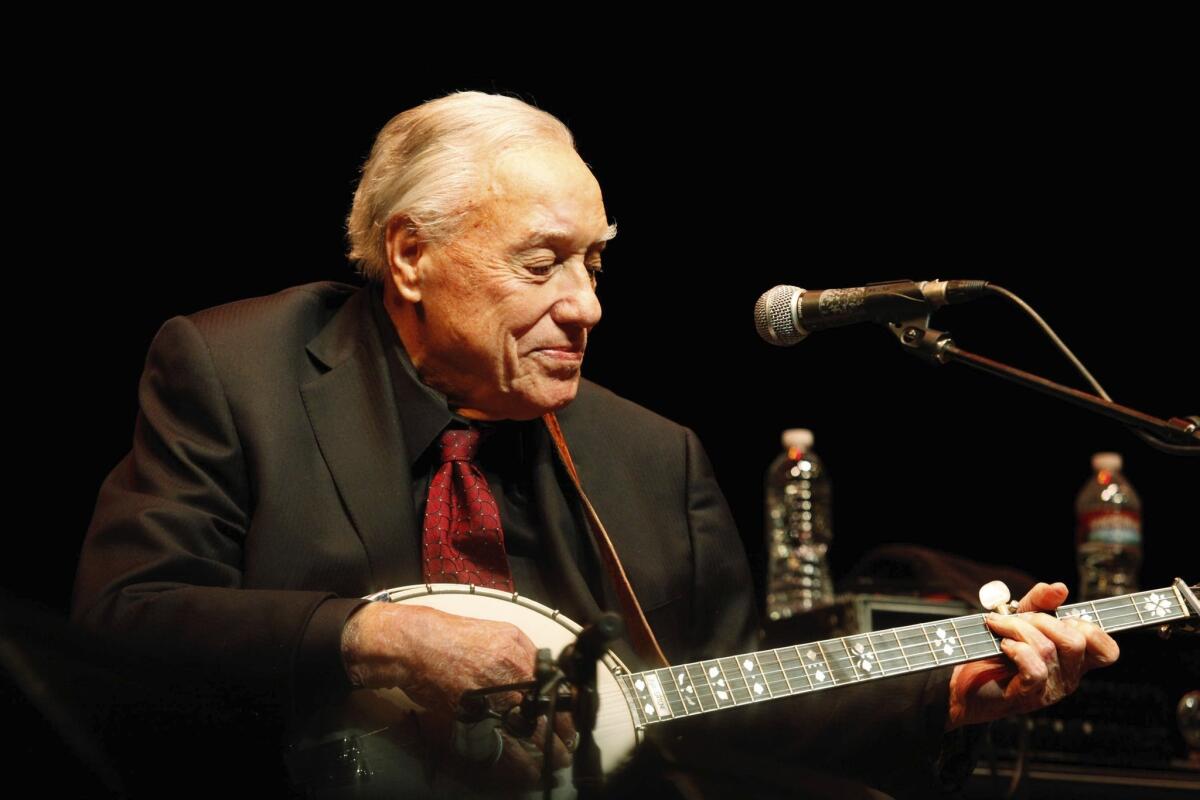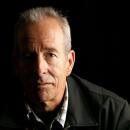Earl Scruggs dies at 88; banjo legend was half of Flatt & Scruggs

- Share via
Bill Monroe, the man widely acknowledged as the father of bluegrass music, was in search of a new banjo player for his famed Blue Grass Boys when a young musician turned up backstage at Nashville’s celebrated Ryman Auditorium during a 1945 Grand Ole Opry radio broadcast, hoping to audition.
Once Monroe and his guitarist, Lester Flatt, heard the sparks fly from 21-year-old Earl Scruggs’ instrument, the bandleader asked Flatt what he thought. “If you can, hire him,” Flatt told Monroe, “whatever the cost.”
Upon joining Monroe’s band, Scruggs solidified a lineup that came to define bluegrass, a rural strain of country music typified by the “high lonesome sound” of tight vocal harmonies and frequently peppered with fleet instrumental interplay among guitar, banjo, fiddle, mandolin and string bass, while wholeheartedly adopting the precepts of solo improvisation and collective empathy of jazz.
Scruggs, who died Wednesday in Nashville at 88 of natural causes, according to his son Gary, brought a distinctive three-finger playing style that became the musical touchstone for thousands of instrumentalists who followed in his wake — among them actor, comedian and banjo player Steve Martin — and helped popularize the banjo far beyond its traditional home in Southern regional music.
Both with Monroe in the 1940s and later during his long partnership with Flatt in Flatt & Scruggs, the North Carolina innovator transformed the instrument from what often had been perceived as a novelty or a prop for comedy into a vehicle for virtuosos. Grand Ole Opry head George D. Hay often introduced Scruggs when the Blue Grass Boys performed as “the boy who made the banjo talk.”
“He was one of the first and the best three-finger banjo player,” Scruggs’ 85-year-old peer Ralph Stanley said Wednesday night in a statement. “He did more for the five-string banjo than anyone I know.”
Scruggs brought the instrument to stardom in mainstream America through hits including “Foggy Mountain Breakdown,” a song he wrote, and even more broadly when Flatt & Scruggs played the theme for a new TV show that became a sensation, “The Beverly Hillbillies,” with the song titled “The Ballad of Jed Clampett.”
Series creator Paul Henning had heard Flatt & Scruggs at the Newport Folk Festival in the late 1950s and invited them to record the song for the sitcom, which premiered in 1962.
“Within three weeks it was rated No. 1 and eventually shown in 76 countries,” Scruggs’ wife, Louise, wrote in the notes for the 2001 all-star tribute album “Earl Scruggs and Friends.” “It spread country music and the five-string banjo all over the world.”
During the height of popularity of “The Beverly Hillbillies,” Flatt & Scruggs’ “Foggy Mountain Breakdown” gained a new following from its prominent use in director Arthur Penn’s hit 1967 movie “Bonnie and Clyde.”
Flatt & Scruggs were hired at the behest of star and producer Warren Beatty, who vowed, “I am going to get Earl a hit record from this movie.” He succeeded, and it also earned the duo their first Grammy Award. Scruggs eventually won three more for various collaborations.
A generation later, filmmakers Joel and Ethan Coen put a bluegrass band at the center of their 2000 Depression-themed movie “O Brother, Where Art Thou?” and called the group the Soggy Bottom Boys, inspired in no small part by the name of Flatt & Scruggs’ band, the Foggy Mountain Boys.
Earl Eugene Scruggs was born Jan. 6, 1924, in Flint Hill, N.C. His father, George, a farmer and amateur banjo player, died when Scruggs was 4, the same year the young Earl took to the instrument, as his four siblings had.
He developed his three-finger style on the five-string banjo by listening to players in the region including Don Reno and Snuffy Jenkins. The approach emphasized clean, fleet picking and syncopated rhythms in contrast to the “claw hammer” or “drop-thumb” styles that had preceded him.
While working as a teenager at a textile mill in Shelby, N.C., he would often play during breaks with a guitarist co-worker. “That’s when I finally realized that what I was doing was of interest to other people,” Scruggs once told the Nashville Tennessean. “They’d stand around and watch us pick. One of them hadn’t heard nothing like that before and he took his hat off, threw it on the ground and said, ‘Hot damn!’ … That’s hard on a hat.”
Throughout his life, Scruggs showed as little regard for stylistic boundaries as he did for the strictures of the banjo playing styles that were most prevalent when he was learning to play.
Beginning in the 1960s, when the country music establishment eyed rock musicians with suspicion or derision, Scruggs exhibited his egalitarian spirit playing with Bob Dylan, Joan Baez, the Byrds, R&B sax great King Curtis, Elton John, the Eagles’ Don Henley, John Fogerty and numerous other rock and pop world figures through the decades.
In the late ‘60s Flatt & Scruggs appeared at such non-traditional settings as the Avalon Ballroom in San Francisco and the Miami Pop Festival at the height of the psychedelic era.
The duo disbanded in 1969. Scruggs then lined up his sons Gary and Randy and started the Earl Scruggs Revue, to which he later added his third son, Steve, and performed around the country and internationally. Flatt died in 1979.
While having hip surgery in 1996, Scruggs suffered a near-fatal heart attack, Louise Scruggs wrote. But upon recuperating, she said, “his health and physical well-being not only began to take flight, it soared. His love for playing and supercharged energy to his performing ability on the banjo became a miracle.”
He remained active into his 80s, appearing at the 2007, 2008 and 2009 editions of the Stagecoach Country Music Festival in Indio. Festival creator Paul Tollett made Scruggs a notable exception to his policy of not repeating acts from one year to the next.
Flatt & Scruggs were inducted into the Country Music Hall of Fame in 1985.
Scruggs is survived by sons Gary and Randy. Louise Scruggs died in 2006, and Steve Scruggs committed suicide in 1992 after killing his wife.
More to Read
Start your day right
Sign up for Essential California for the L.A. Times biggest news, features and recommendations in your inbox six days a week.
You may occasionally receive promotional content from the Los Angeles Times.







